An inventory spreadsheet template is an inventory management tool used by businesses to track, manage, and control assets or resources within the business or company meant for production or selling.
These templates are simple to use and inexpensive. It records details of the resources owned by a company at a particular moment in time. Inventory can be raw materials, work-in-progress, or finished products. Details captured in it are item type, product description, SKU, unit price, purchase price, quantity, product cost, expiration date, purchase date, and supplier information. This information is used to decide when to restock or sell the resources at hand.
Additional details, such as the condition and current location, can be added. This way, a business remains in control of its stock and keeps the production lines running while making a profit from sales. In addition, they ensure the business does not spend more on materials than it can earn.
Inventory spreadsheets are meant to facilitate the management of resources and ensure a balance between inventory and sales. They are also used to forecast production costs and identify cost-cutting solutions in the production lines by comparing previous and current resources’ costs. It is also an effective record-keeping tool for a company.
Inventory Spreadsheet Templates
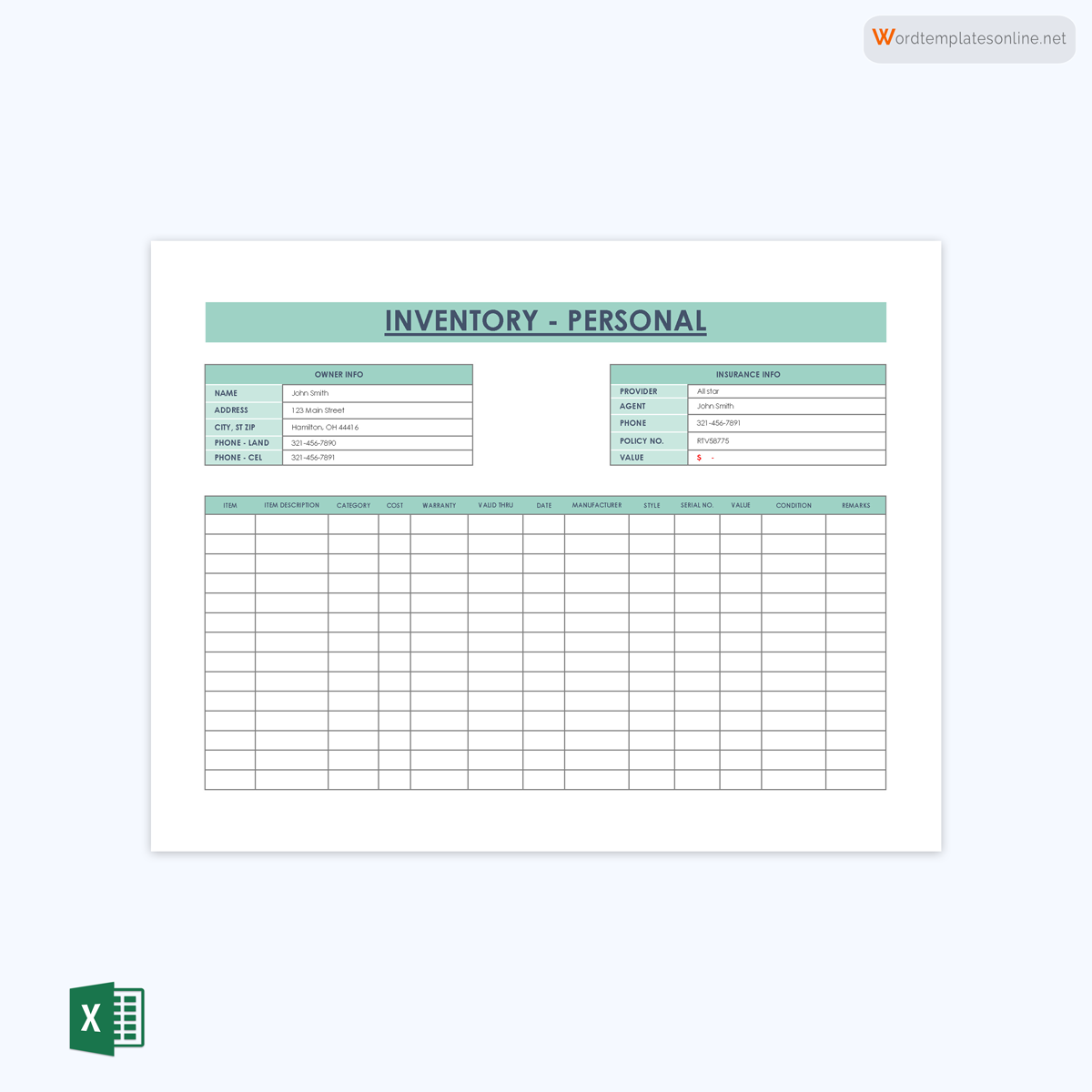
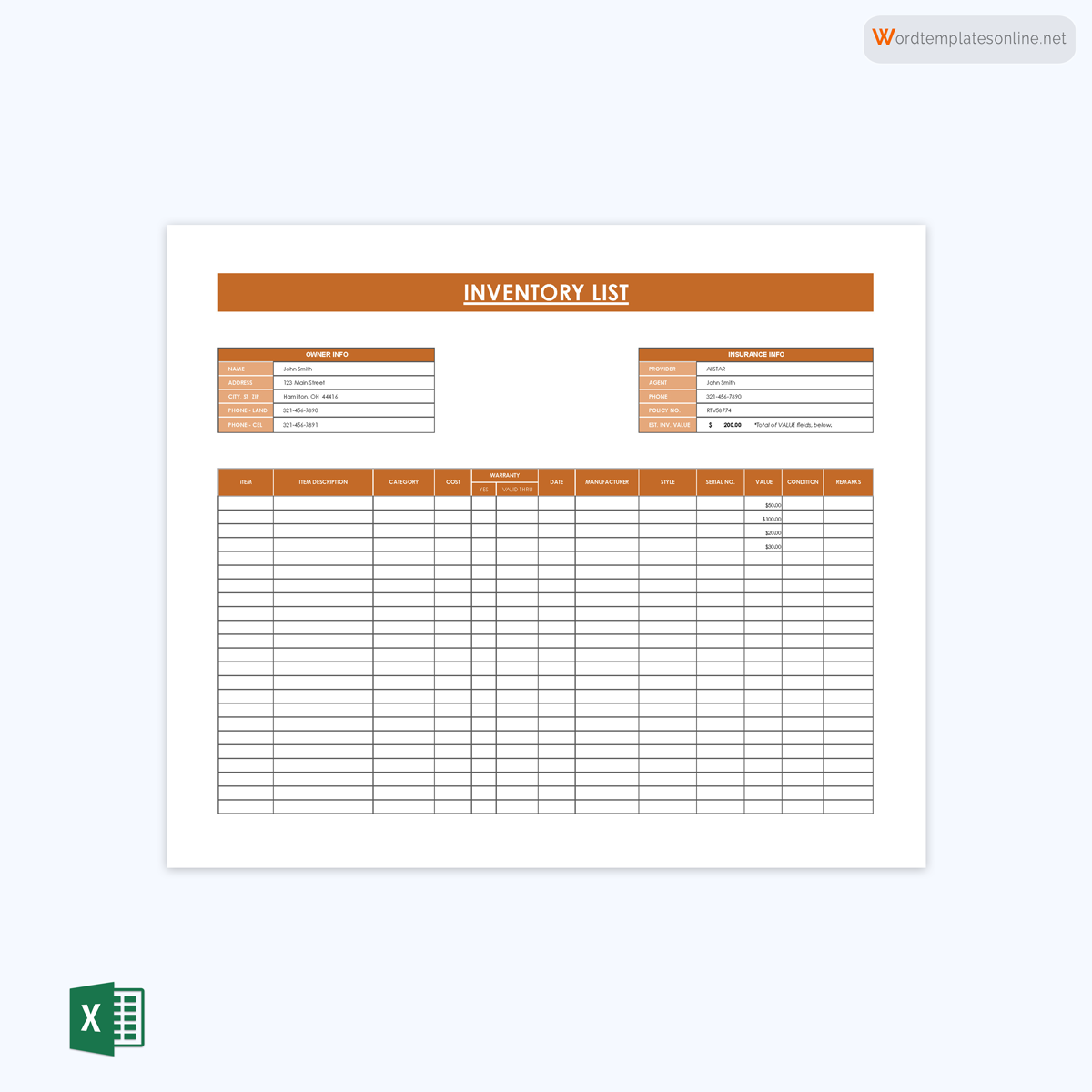
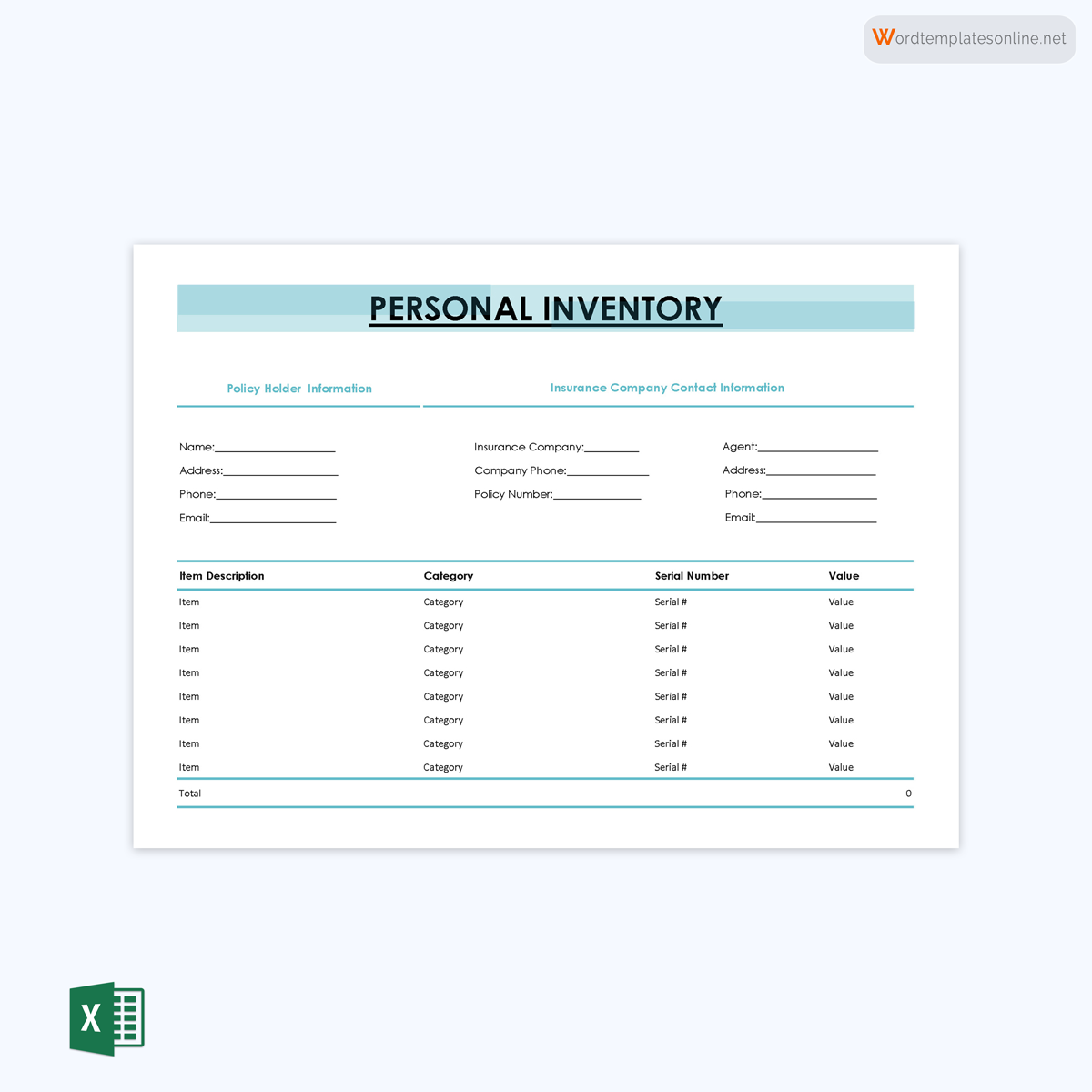
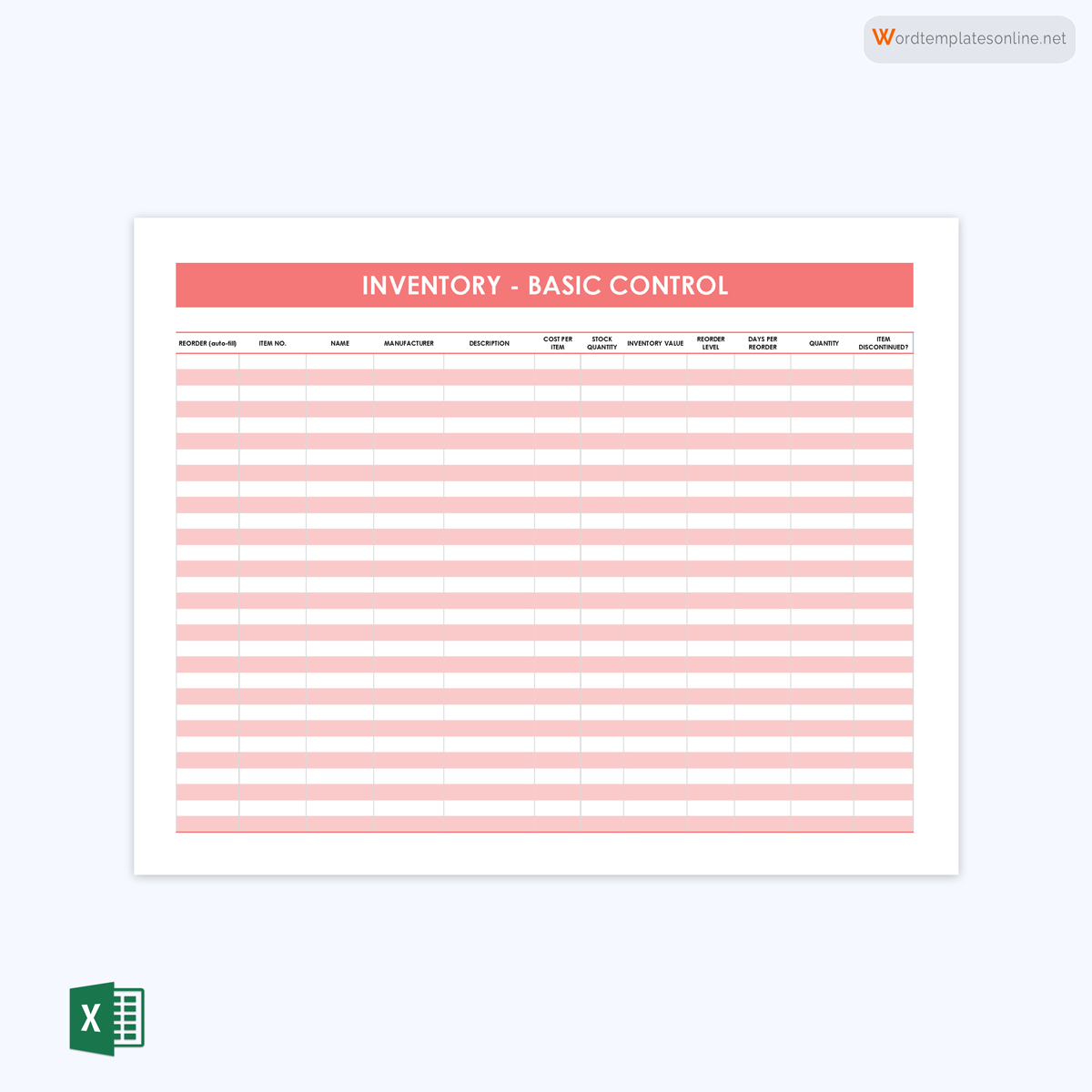
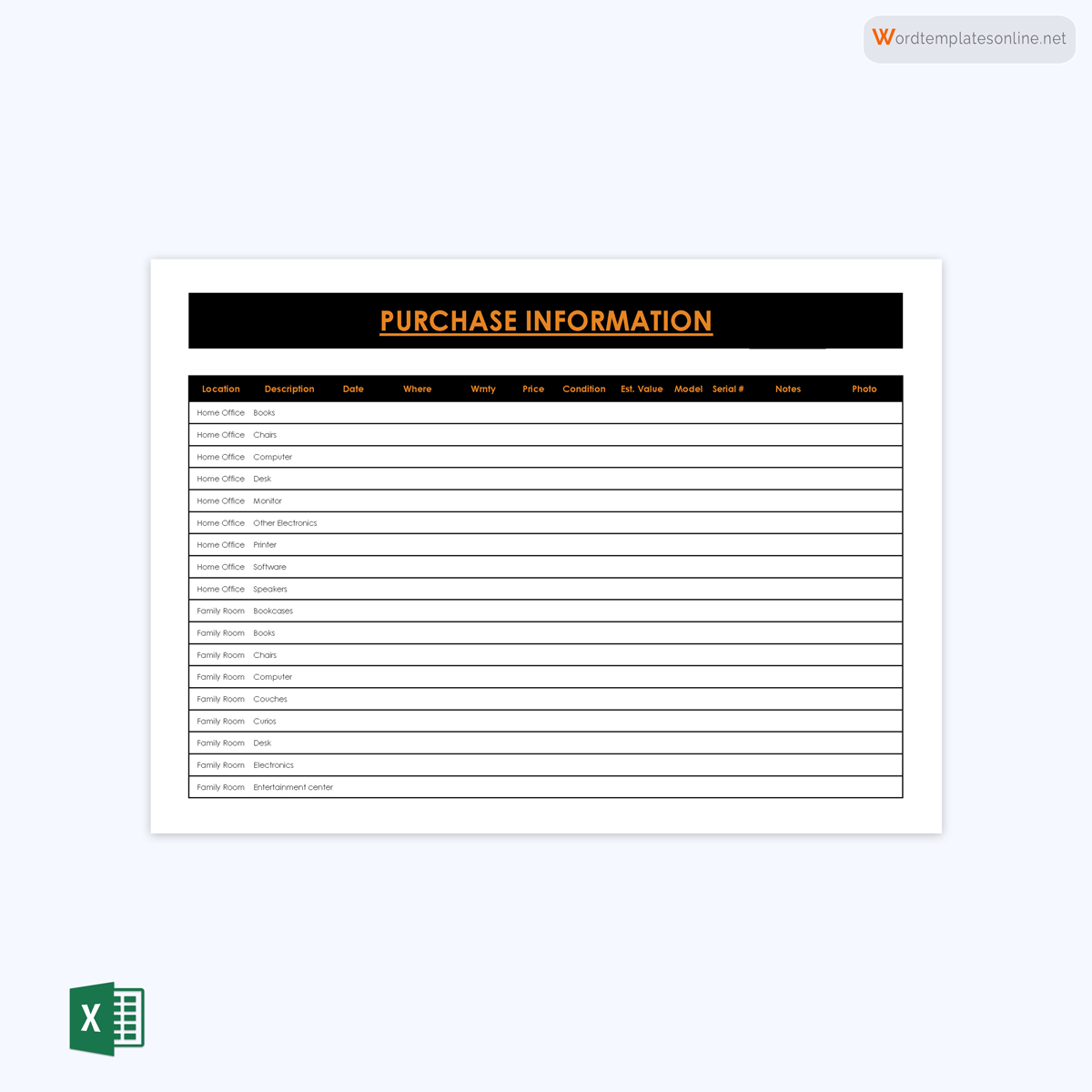
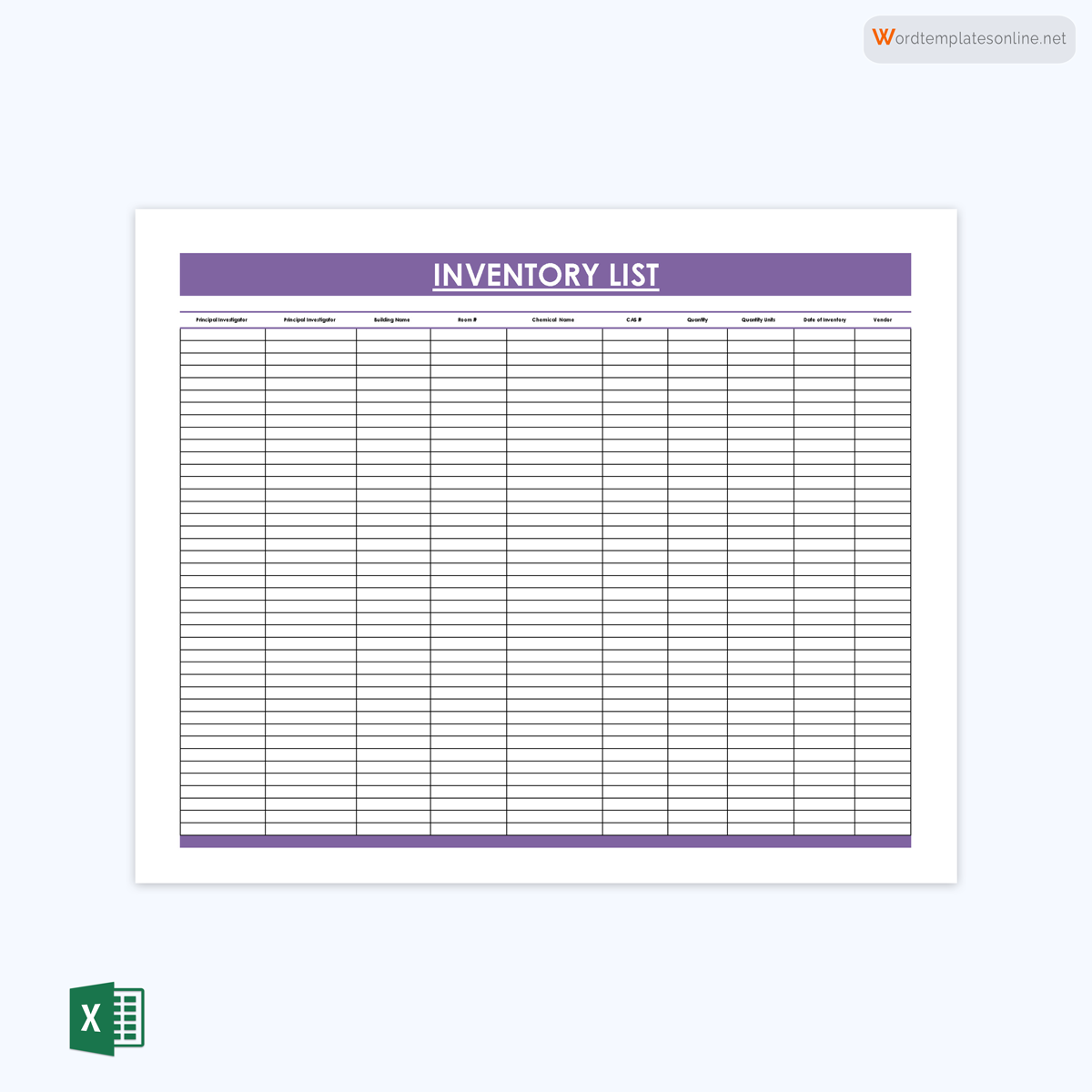
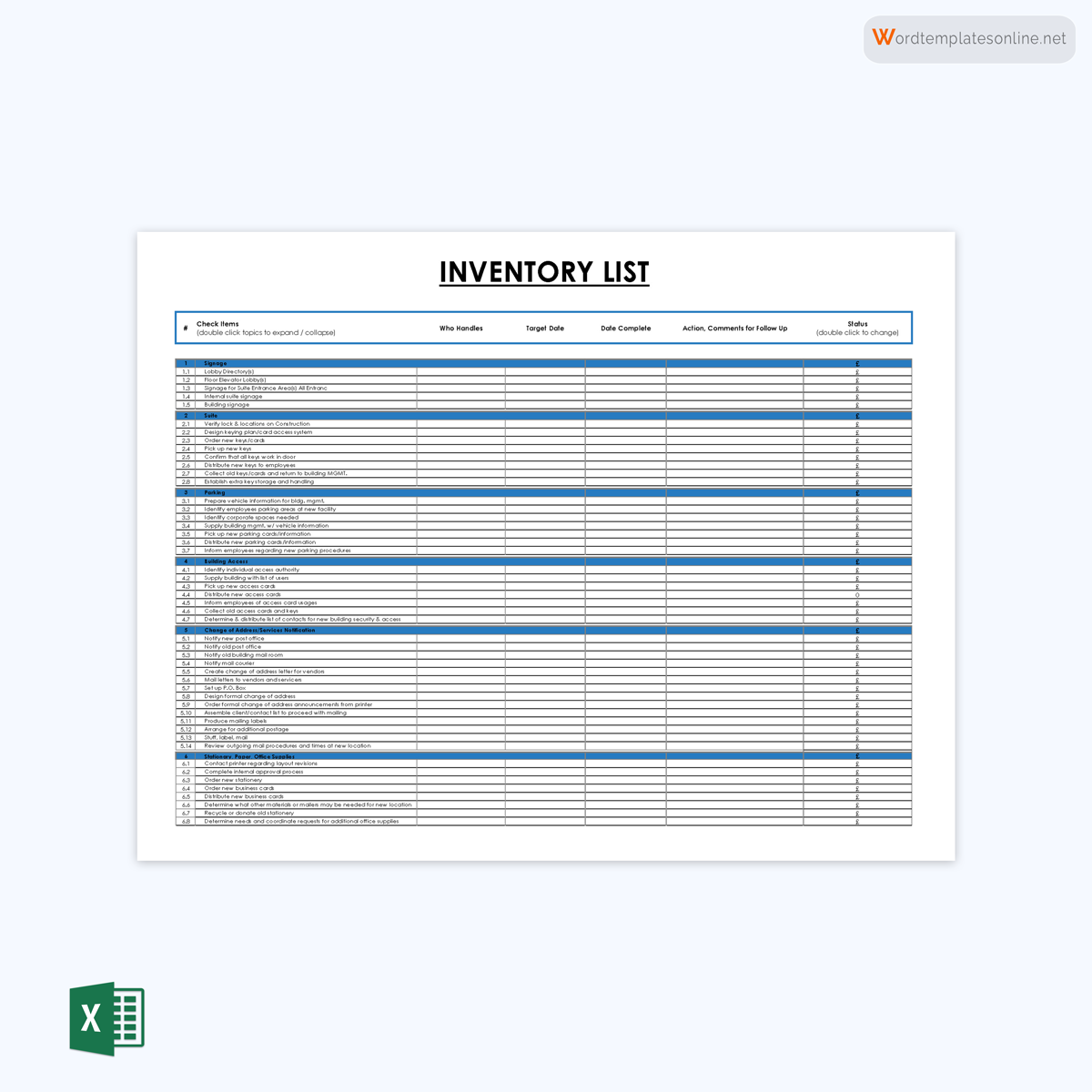
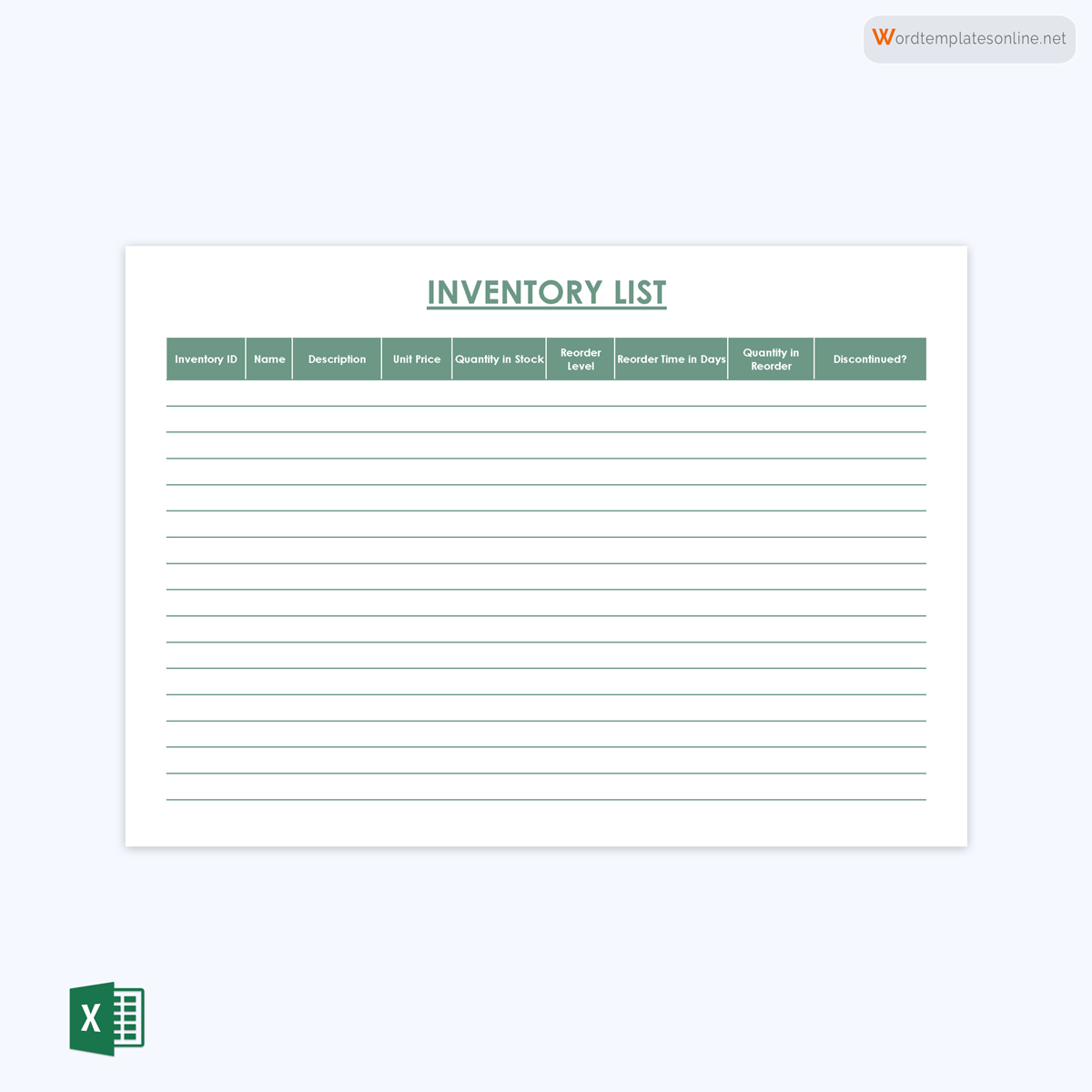
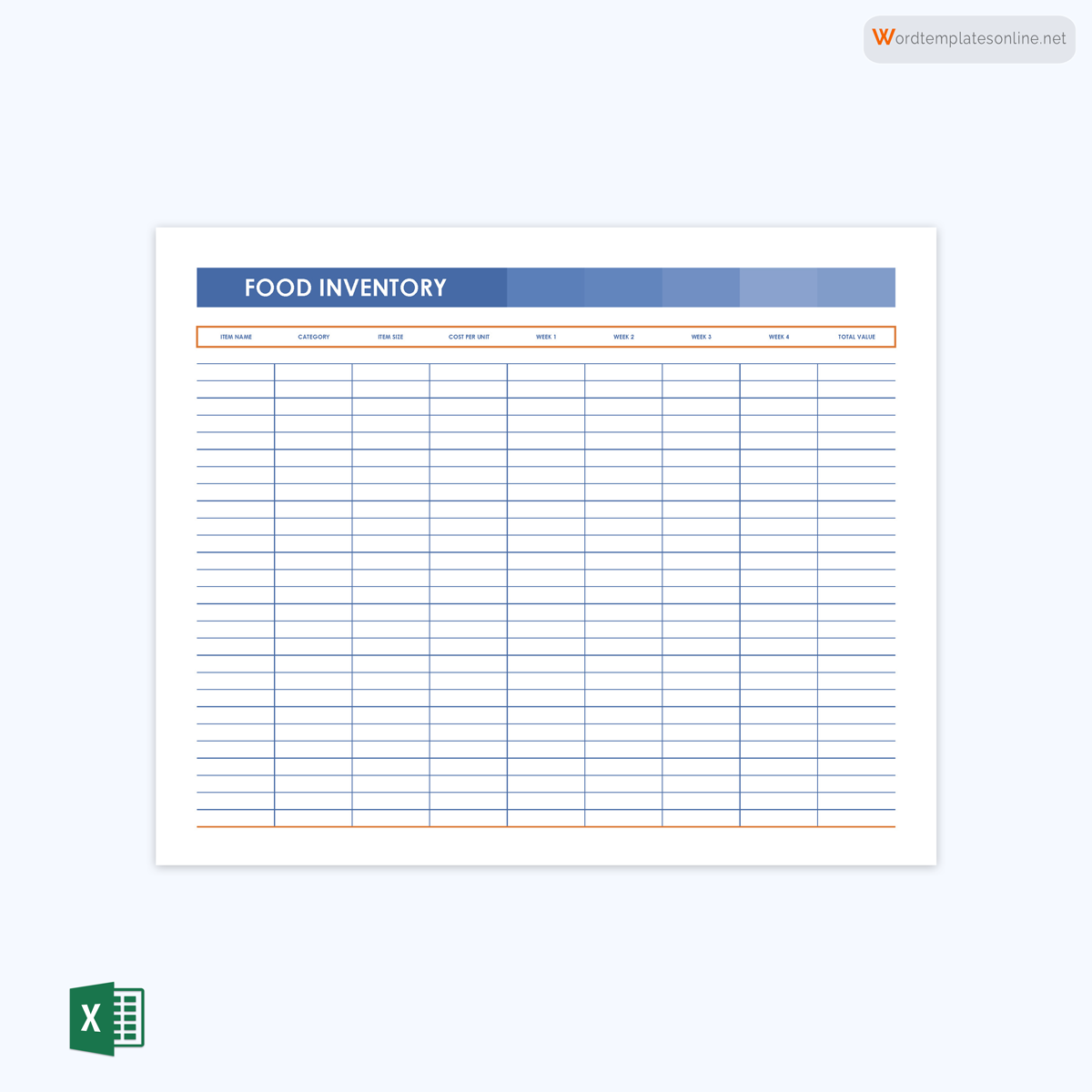
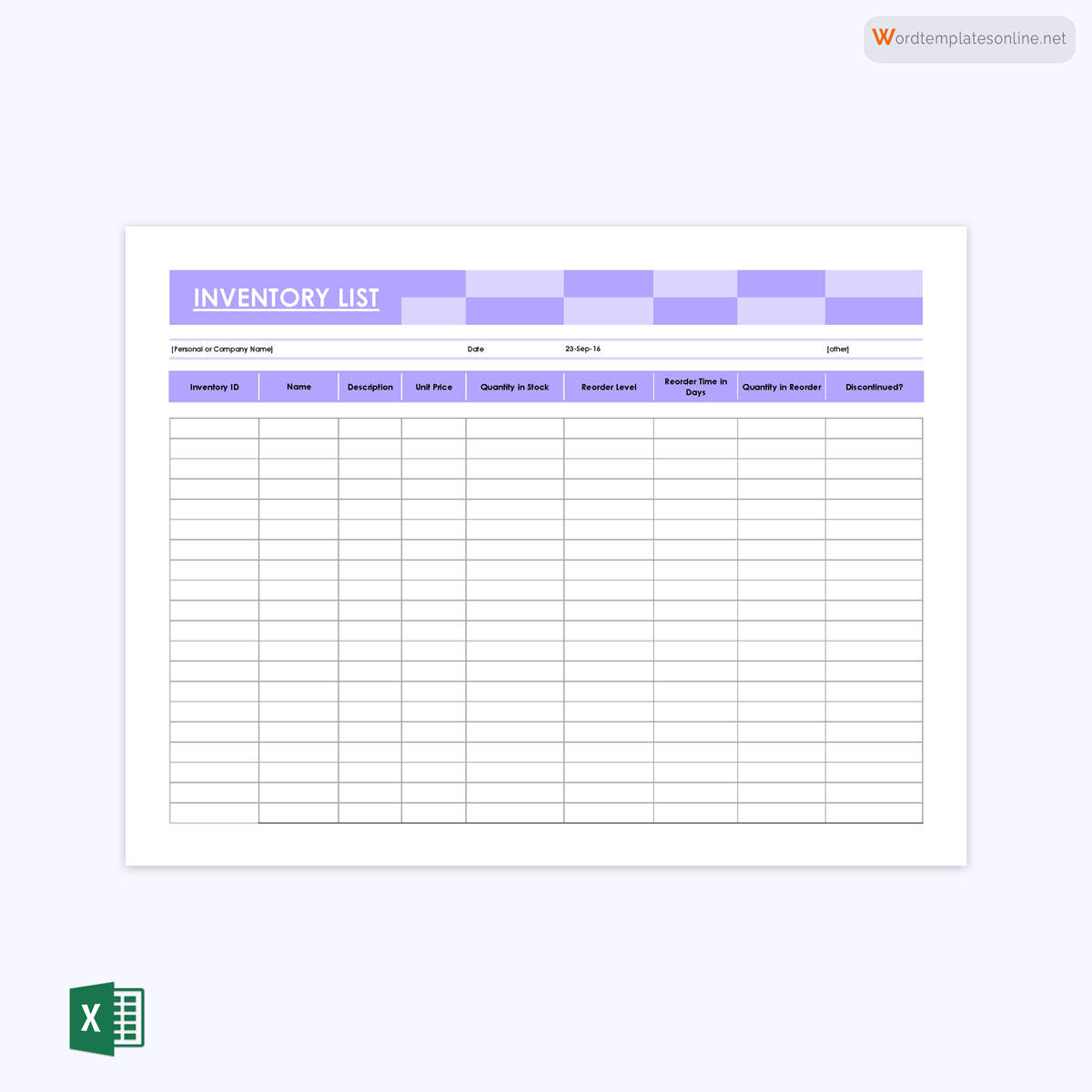
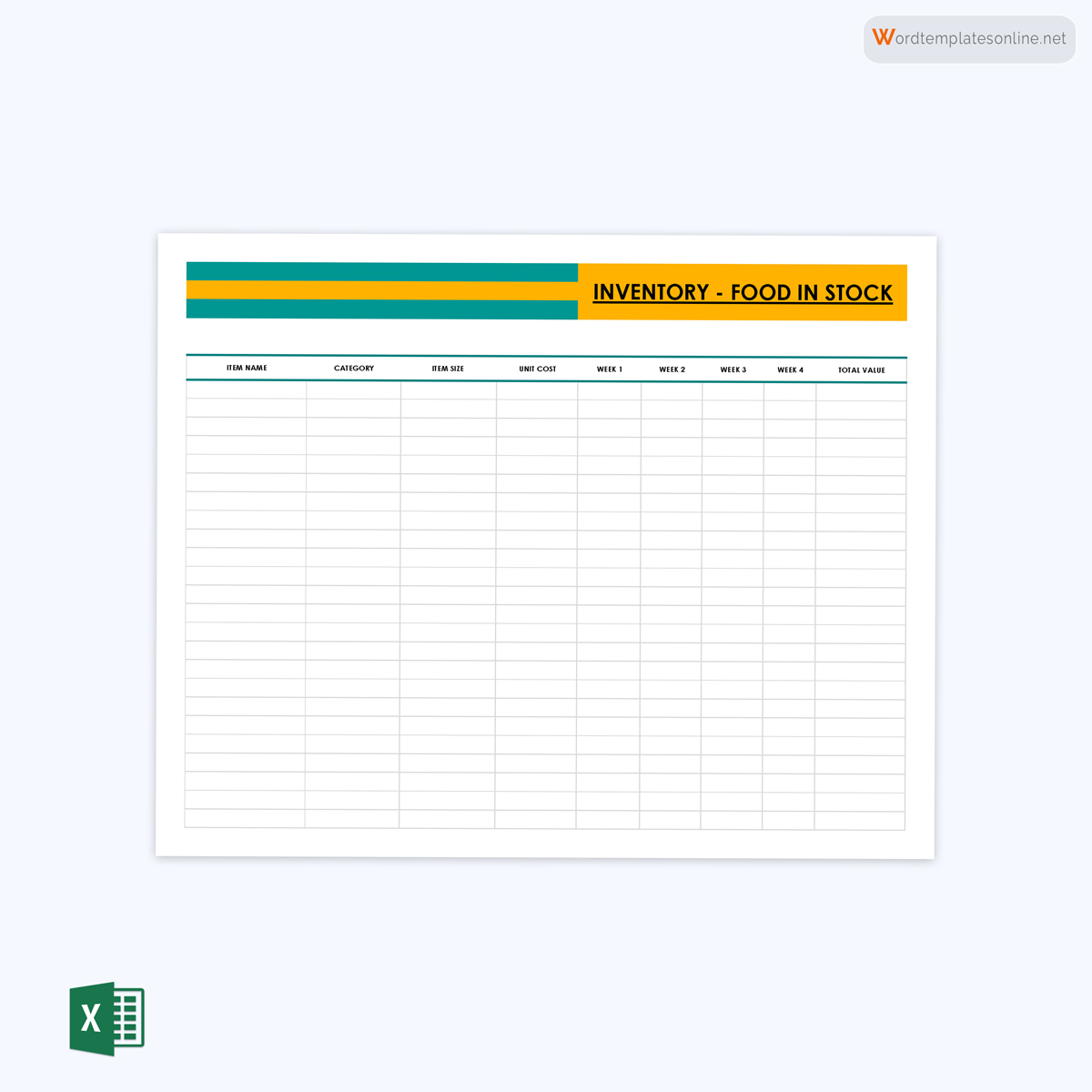
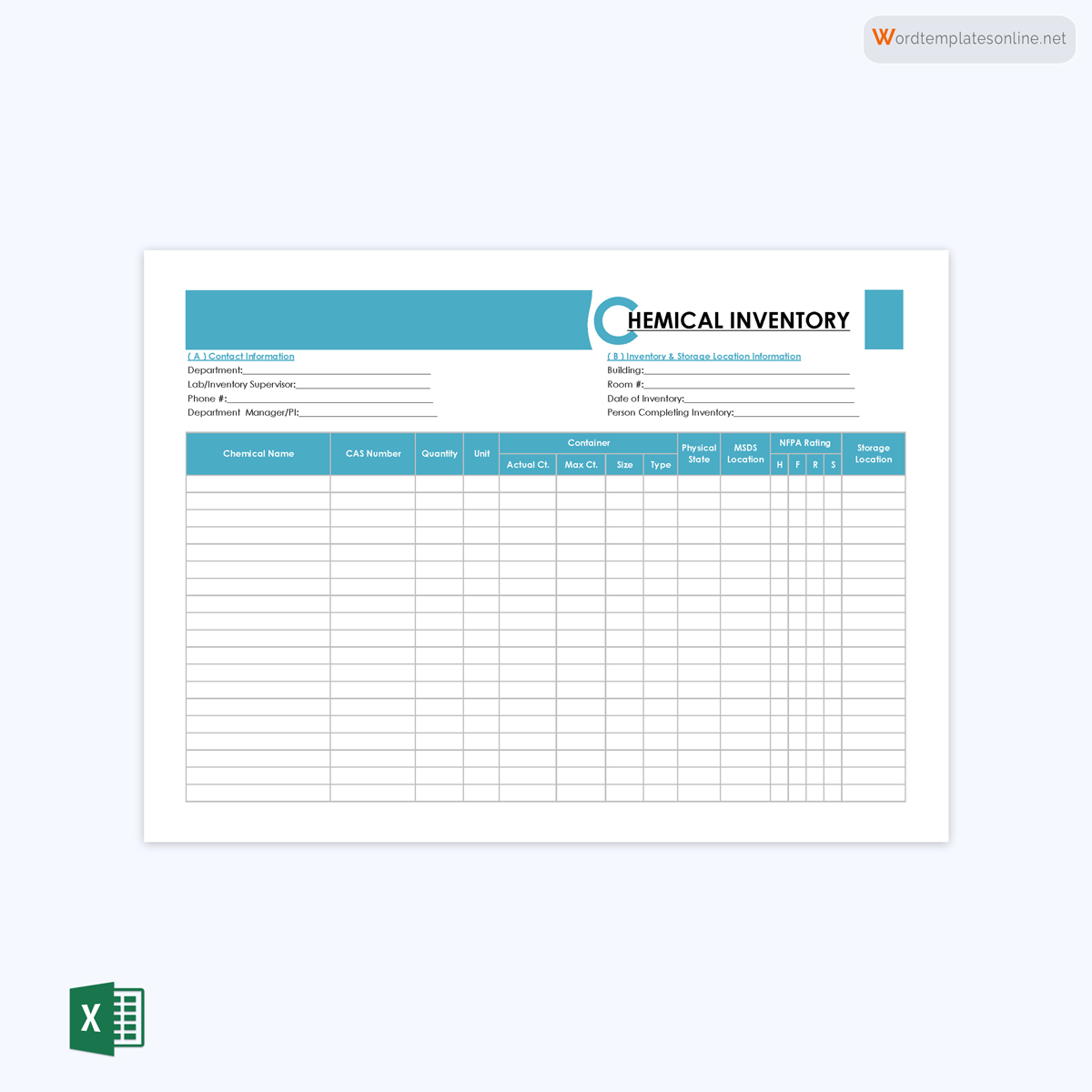
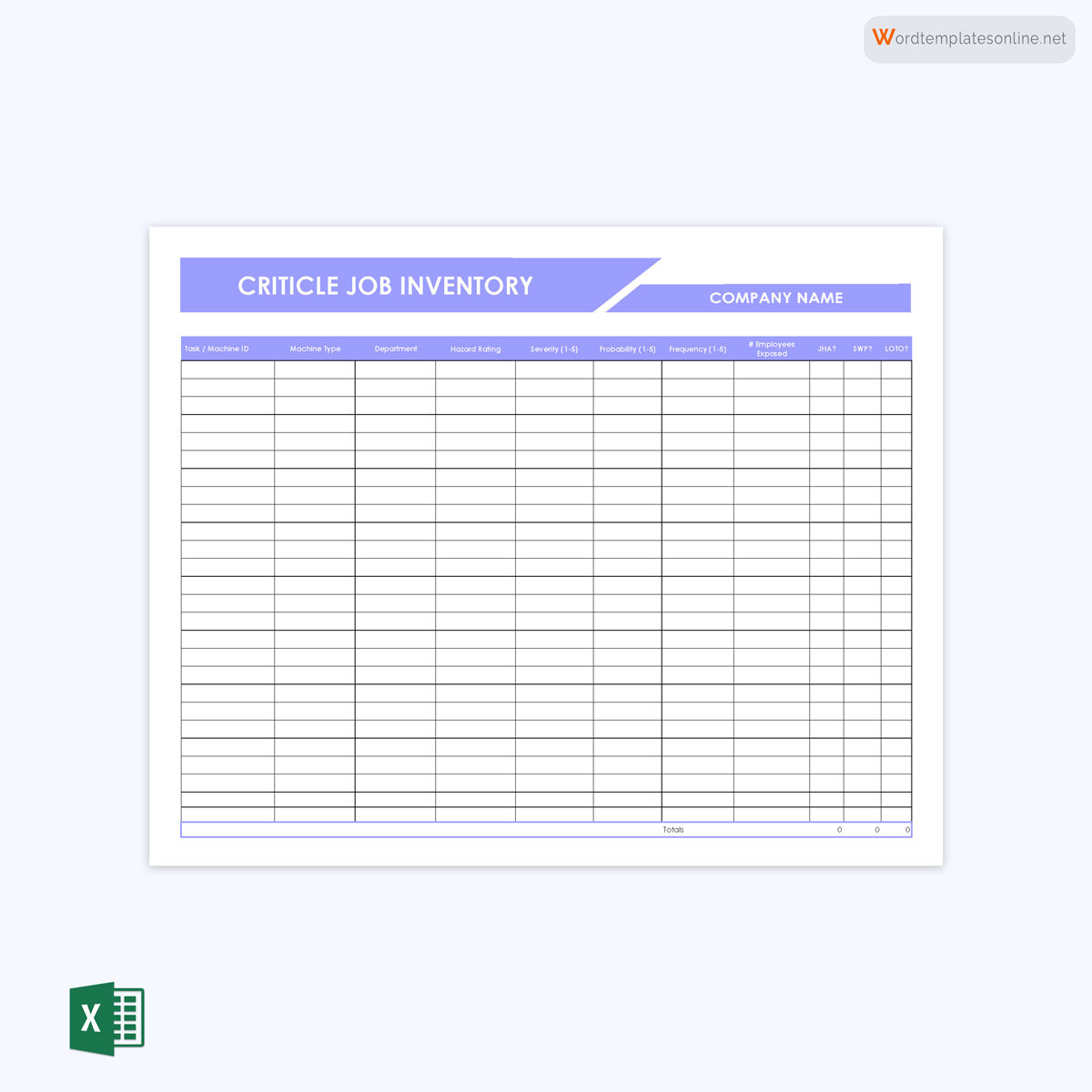
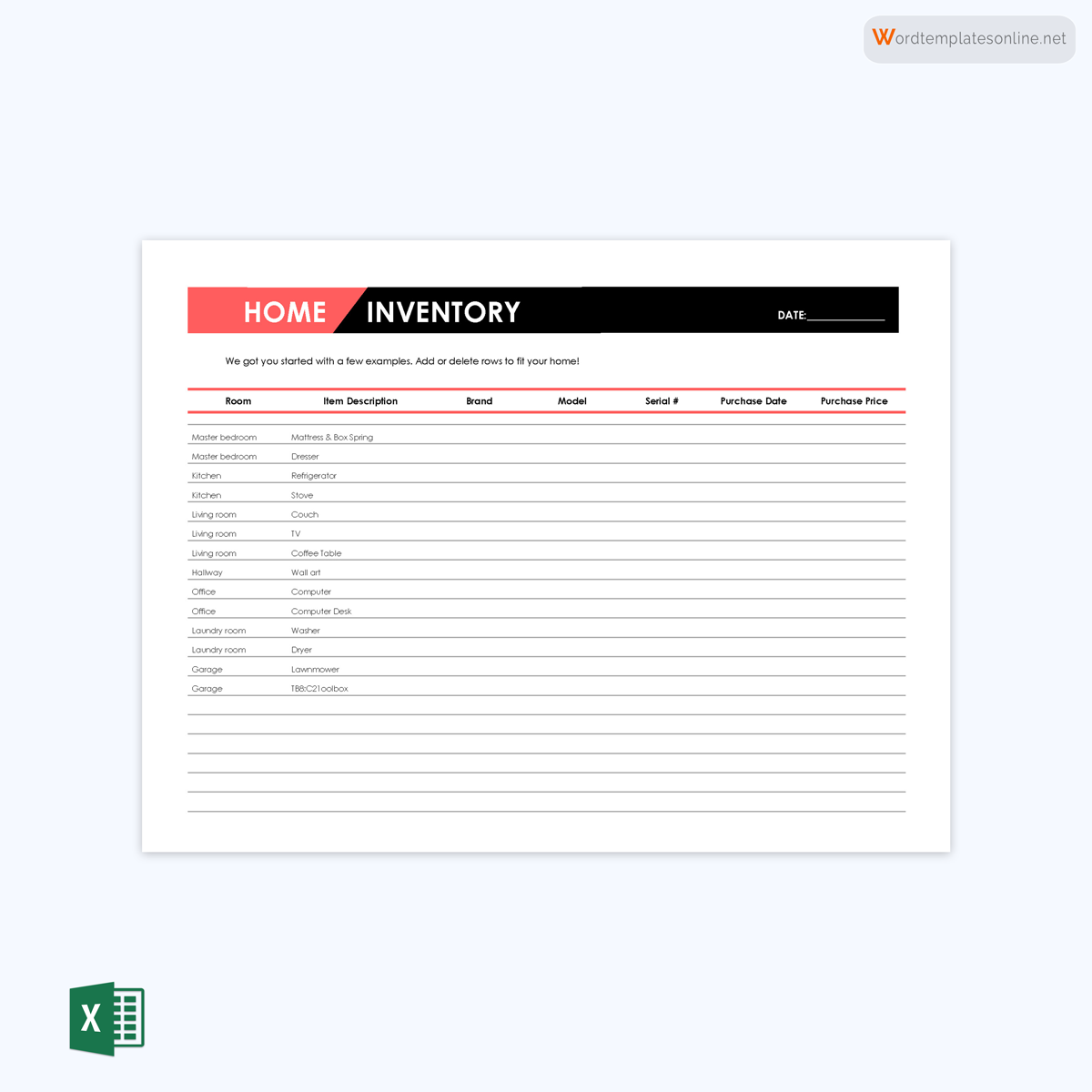
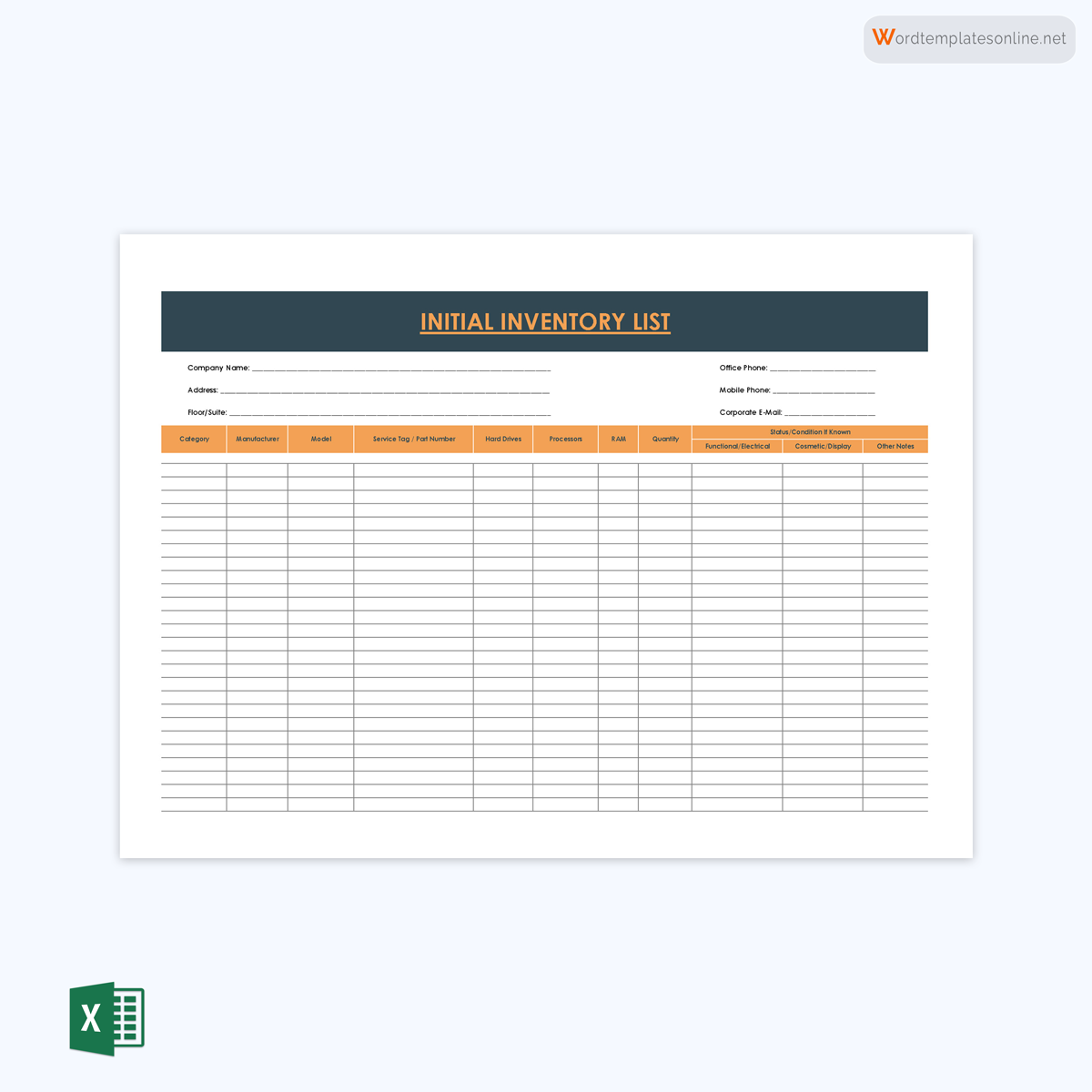
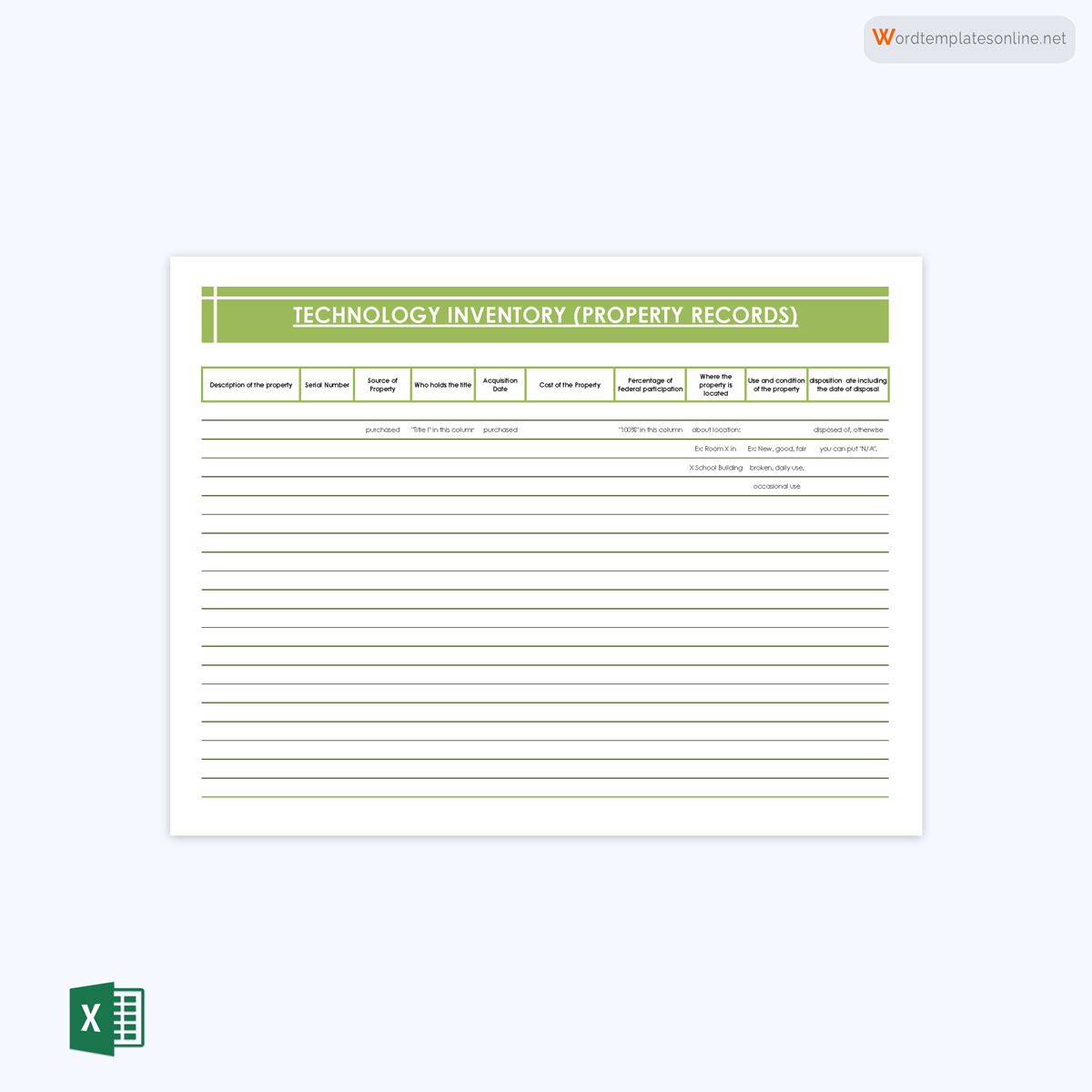
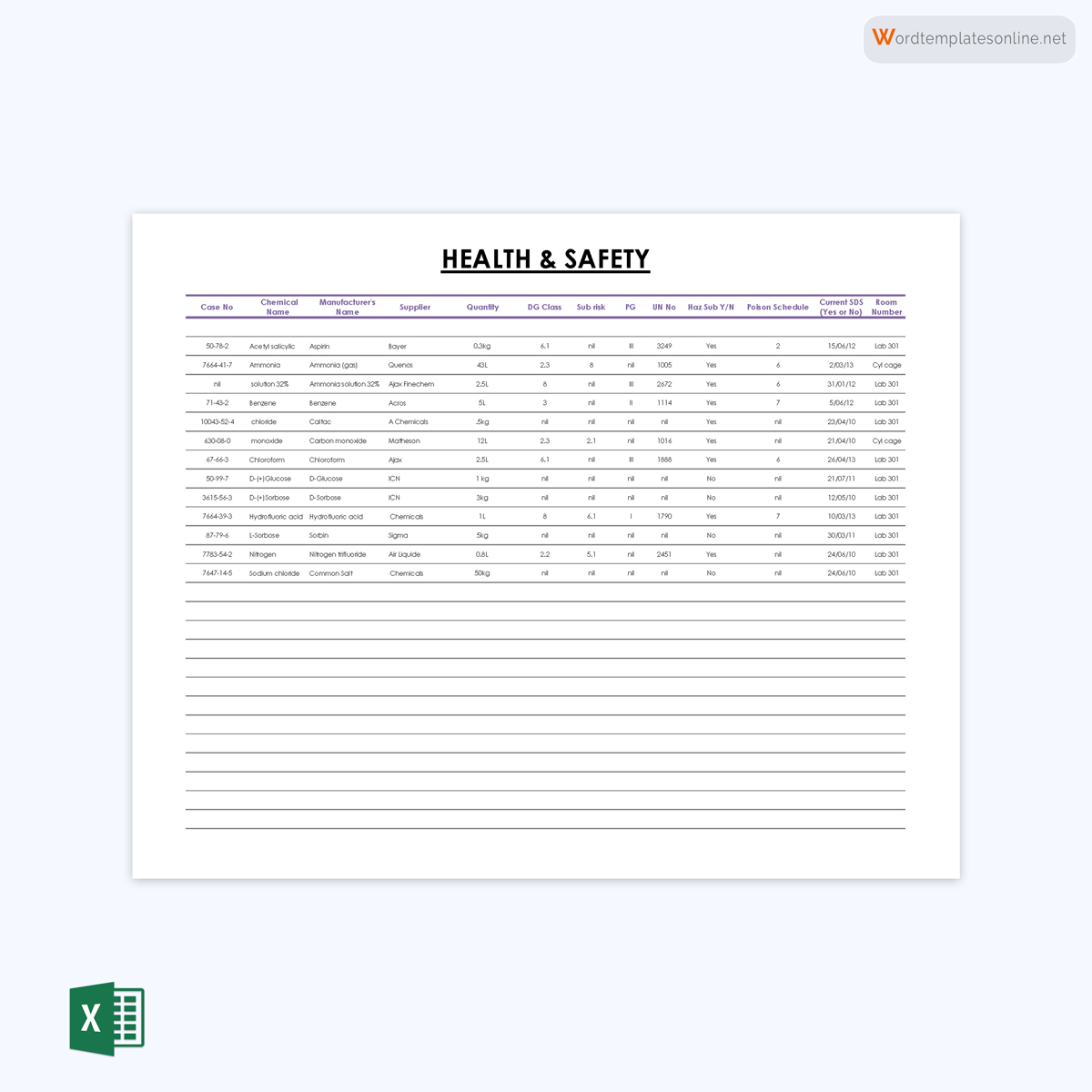

What is the Purpose of an Inventory Sheet?
The inventory sheet serves many purposes in ensuring the success of the business goal:
- Keeping a record of goods and materials: It keeps a record of every item in the business. This ensures the smooth running of the business.
- Budget planning: It keeps a record of all items in stock. This will help in your budget planning to know what to add and what is in excess. Inventory sheets are equal to the money in the business. It also helps in planning the project that the business should undertake at that time. For instance, the sheets can help you concentrate on paying business loans because the inventories in stock will run the business for the next two months. And so you can comfortably pay the loan with no fear that you will go out of stock.
- Ensuring customer satisfaction: Customers have nothing to do with stock-taking or shipping; all they want is to get their commodities when they need them. Failure to do this can lead to the loss of the customer, which translates to future potential loss. An inventory sheet helps you know that what a customer needs will be available by the time they get it.
- Enhance efficiency: It keeps the record of the business running. Keeping an up-to-date document shows you goods in stock, the goods or materials sold, the goods and materials ordered from the manufacturer, and the cost of purchase as well as the cost of selling. This helps in measuring business efficiency at the end of it all. This ensures that the demand and supply of goods and materials are in balance.
Types of Inventory Spreadsheet Templates
Depending on the utilization, there are distinct types of inventory spreadsheet templates. These are not limited to businesses and companies; they are applied in multiple scenarios.
Look at the different types discussed below:
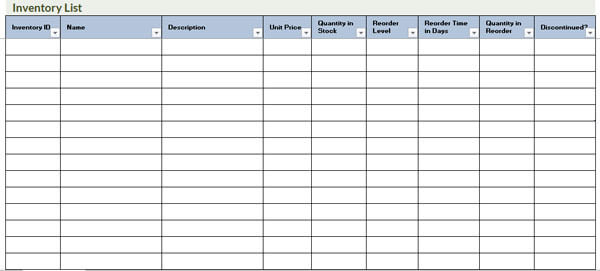
Stock inventory control template
Any type of business uses a stock inventory to determine their reordering schedules, reduce excess inventory, and locate items. It also contains vendor information. This type of inventory list outlines the entire lifecycle of the business’s stock.
Download: Microsoft Word (.docx)
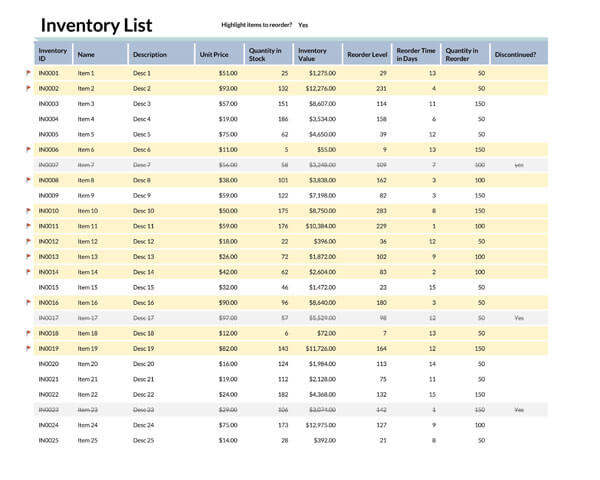
Basic inventory control template
A basic inventory list is a simple and easy-to-use inventory list that can be adopted by any type of business that doesn’t require too detailed stock tracking. It outlines basic information like the item name, unit price, and product description or ID number. It is a more straightforward tool to use and record current inventory quantity, restocking dates, and determine discontinued items.
Download: Microsoft Word (.docx)
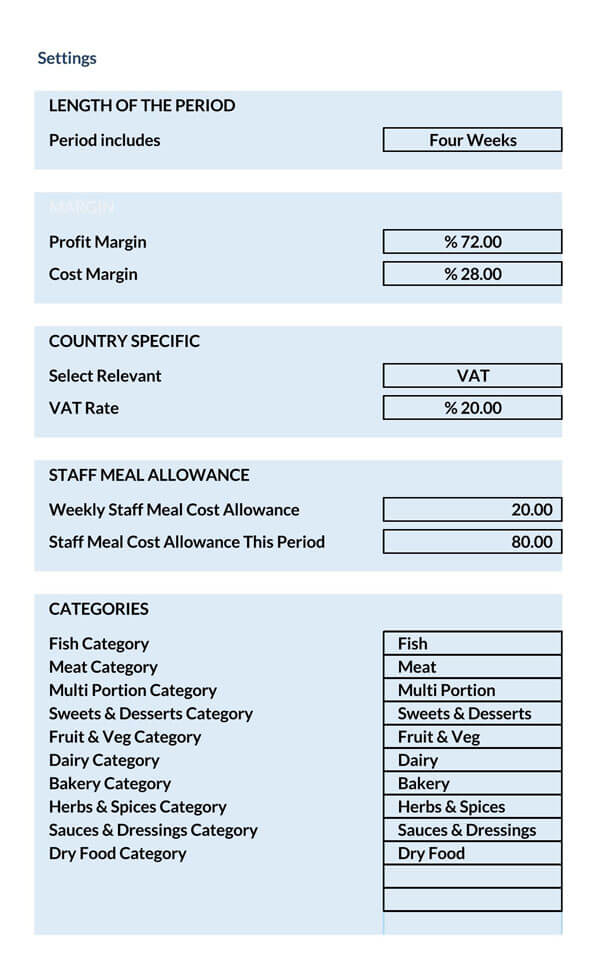
Food inventory template
A food inventory list is specifically meant to track food stock and is thus more common among restaurant and catering businesses. It classifies inventory based on the type of food and records the quantity and cost of the stock.
Download: Microsoft Word (.docx)
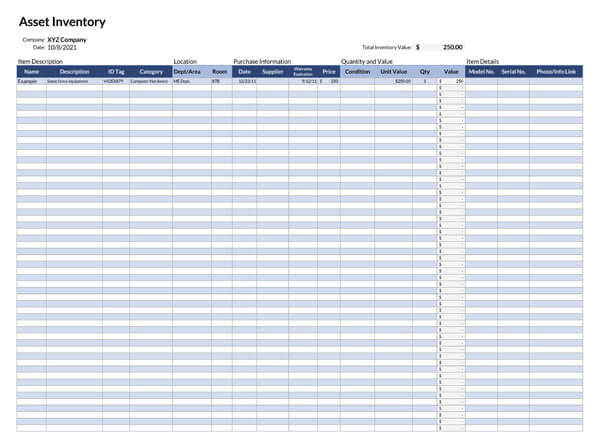
Asset tracking template
An asset tracking template is used to track the quantity and value of company assets like equipment and tools that require periodic maintenance. It is popular among small businesses. The template outlines the item name, serial number, warranty dates, physical location, and supplier information.
Download: Microsoft Word (.docx)
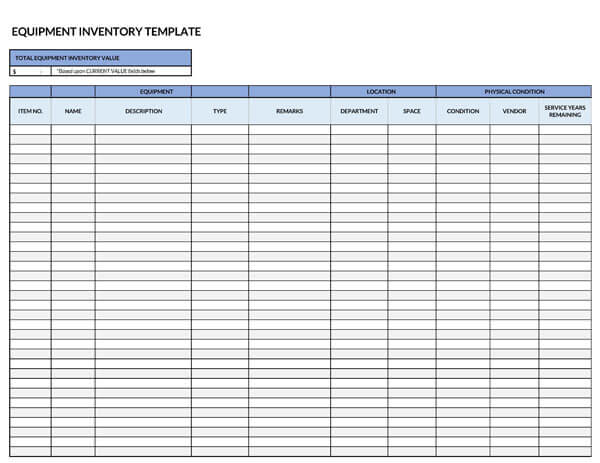
Equipment inventory template
An equipment inventory template is utilized to track the value, location, condition, operating costs, value, depreciation, and loan balances of costly equipment in a company. This information is used to determine when equipment will be serviced, upgraded, and it also optimizes operating costs.
Download: Microsoft Word (.docx)
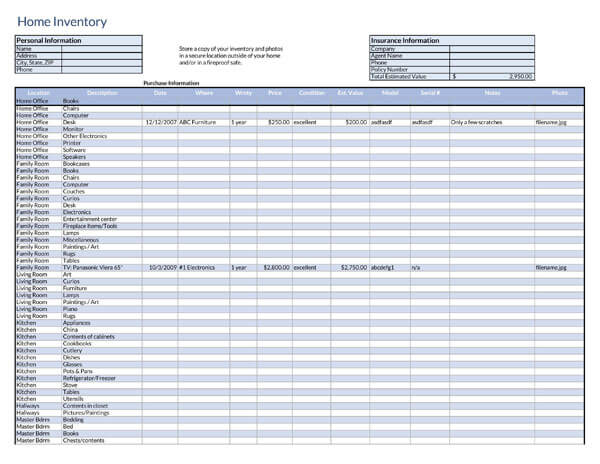
Home inventory template
Homeowners use a home inventory template to record personal possessions within their household. The inventory spreadsheet template can record the item type, purchase price, current value, and serial number. It also allows the categorization of the inventory based on the number of rooms. This information is used to claim insurance after circumstances such as natural disasters, fires, or burglary.
Download: Microsoft Word (.docx)
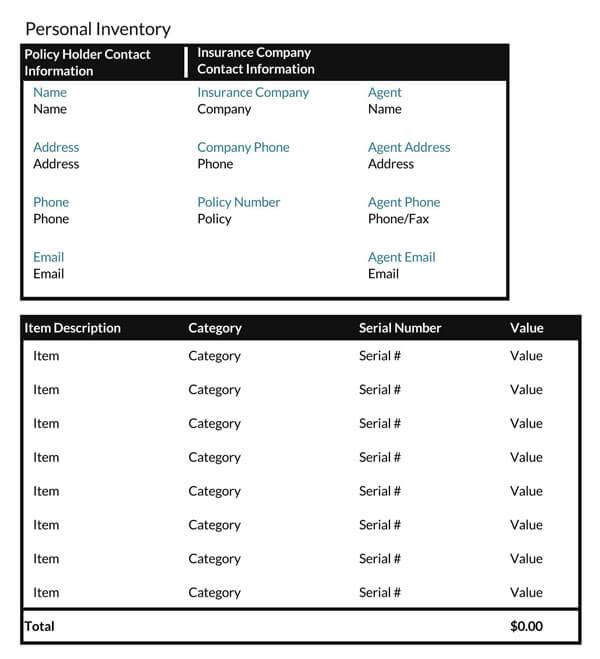
Personal inventory template
People can also keep track of their personal belongings through a personal inventory template. It records the item type, value, and condition. Personal belongings ordinarily tracked by the template are artwork, books, etc.
Download: Microsoft Word (.docx)
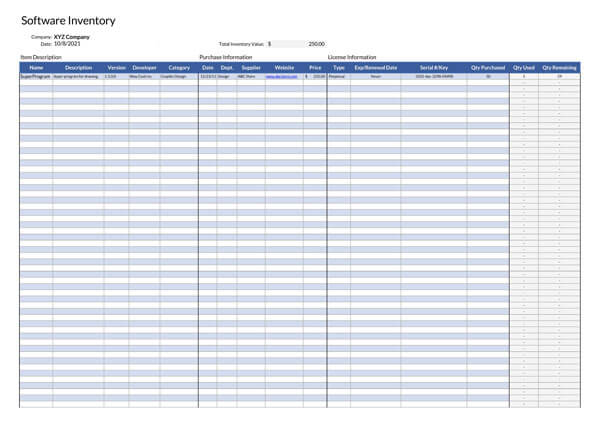
Software inventory template
IT specialists need to keep track of their software inventory. A software inventory template allows them to do just that as is it is specifically designed to track software. It records information such as product name, version/model, installation dates, license expiration dates, supplier details, upgrades, etc.
Download: Microsoft Word (.docx)
Types of Inventory List
There are four major types of inventory. These types of lists create different types of lists. Therefore, it is imperative to understand the types that are common among businesses.
The following are adequate definitions of different types:
Raw material
Raw materials are items or resources a company uses to create finished products for sale. Raw materials will vary from one production to the next, depending on what product is being produced. The raw materials are unrecognizable after the product is completed.
EXAMPLE
Raw materials for a clothesline manufacturing company will be fabric, dyes, thread, and print designs.
Work-in-process
Work-in-progress inventory represents all items made from raw materials up to just before the finished product is made. This type will often be due to the combination, processing, and assemblage of raw materials.
EXAMPLE
Circuit boards, capacitors, batteries, and a screen were later assembled to produce a phone.
Finished goods
Finished goods are the final goods or products ready for sale to consumers. For example, a well-packaged mobile phone. Keeping track of finished goods helps in assessing customer demand. This is done by using a finished goods inventory list template that outlines detailed descriptions of the finished product.
EXAMPLE
Toys, medicine, vehicles, electronics, furniture, etc.
MRO goods
MRO is an abbreviation for maintenance, repair, and operation. MRO supplies are also an essential inventory to track. They are used to keep the production process functional.
EXAMPLE
Security cameras, computers, repair tools, office supplies, furniture, etc.
Basic Contents of an Inventory Sheet
A standard inventory sheet is laid out in rows and columns. It consists of many columns, such as the number of every inventory:
- Name: The first detail to indicate is the specific name of the inventory. The details and description are written across the row, while down in the column are the names of each item.
- Category: The second row is the category row. This is the category that the inventory falls into as per your classification of goods and materials that you deal with. For instance, groceries, pharmaceuticals, cosmetics, and such.
- Availability: This is the number present in the stock.
- Date and time: This is the date and time that the stock was checked.
- Unit price: This is the unit price of a single item.
- Value: This is the total value of all the similar inventories in stock. This is obtained by multiplying the availability number by the unit price.
- Lead time in days: This is the estimated time that the goods can take from the time of order to the time it is supplied.
- Reorder point: This is the unit quantity of stock at hand. This is obtained by multiplying the average daily demand rate with the lead time.
- Order Quantity: This is the number or volume required to be ordered so as to meet the demand while reducing the cost per order.
How to Create an Inventory Spreadsheet Template for Excel
Excel is the most common tool for creating inventory spreadsheet templates. It allows businesses to create personalized documents to track their inventory. The procedure is given below:
Begin by opening Microsoft Excel and creating a “Blank Document” under the file command. Next, navigate to the Insert Tab and select the Header command to create a header for the template. Add text to the header. Name the template depending on the purpose, for example, “Food Inventory Template.”
The next step is to create sections to input details. The first row of the template is supposed to contain the classifications, and each item type should appear in its column. To input the first classification, select column 1, row 1, or A1 and name the column “classification one, e.g., Product Name.” Next, go to column 2, row 1, or B1 input “Classification two, e.g., Serial Number.” Next, move to column 3, row 1, or C1 and input “Classification three, e.g., Product description.” Follow the same process depending on how many classifications are needed in the template. Examples of standard classifications are the number of units in the stock, sale price, minimum order quantity, order time, and supplier.
Lastly, save the template. Saving the template is significant in making sure it is accessible in the future. In addition, the color and font can be customized to align with the company’s brand.
How to Use an Inventory Spreadsheet Template
Using an inventory spreadsheet template for Excel is simple and quick, and it can save time and the hassle of having to create it from scratch.
The following simple steps can be adapted to complete any template for Excel:
Create your template
The first step is obtaining a template that fits the business or company in question. One can create it using the guide provided in this article above. This way, a personalized version that will incorporate all the needed information is available.
Print it out
Print out the template. Using a physical template placed on a clipboard is recommended to input details as one physically counts the inventory. Ensure to capture all the key information.
Make necessary changes and improvements
Next, as one makes rounds in the storage area, be keen to identify inconsistencies and inefficiencies in the inventory. Note them down as notes. Note down any changes and improvements that come to mind during the trip. One should take their time while doing this; hurried recording can lead to missing information.
Transfer data onto the smart sheet
Once the physical template has been completed, transfer this information onto the spreadsheet in Excel. Carry out needed calculations such as total costs and quantity. One can opt to use in-built Excel formulas, which are faster if well mastered, or simply do manual calculations, which are still as effective. Be thorough when transferring information; human errors are usually prevalent at this stage. Transfer true and accurate data.
Maintain data over time
Lastly, always update the inventory list after every audit. Create a new tab for every audit in order to have a much-needed history. Some companies review it weekly, bi-weekly, or monthly.
Having a good inventory management strategy can help a company or business in more than one way. This article will look at the different benefits of incorporating these templates for Excel into inventory management.
They include:
View current levels
The list outlines all the items currently in stock. This ensures the information is readily and easily accessible, and the business can determine when to restock and how much stock is needed.
Stay organized
The organization is essential to smoothly running a company and this is a tool that effectively keeps data on the inflow and outflow of resources in a company which facilitates the organization of the business. Production delays are thus avoided due to a shortage of materials. Finished products are therefore delivered on time, and customer satisfaction is achieved. As a record-keeping document, management can also control spending.
Create business statistics
With the cost and quantity of raw materials and stock in the business recorded in the list, the company can have real-time business statistics that can be used in decision-making.
Protect your investments
With all items possessed by a company or a person recorded, it is easier to protect these items as current audits can be compared with previous audits to determine if all the items are still intact. Additionally, with a list of all inventory, a company or person can claim insurance for their assets after loss or damage from natural disasters or events like fire.
Save time, money, and effort
With a template, it is easy and fast to collect information on the available stock in a business. By having it in one place, less time is used to locate items in storage, and people don’t have to make long trips to the storage to determine what is available and what is not. Also, a template can be created by Excel, which comes at no cost, thus increasing the affordability of managing company resources. By having a list of current resources, the business avoids buying items that are not needed, thus saving money.
Ease of use
Using templates for Excel is more accommodating to people who have basic knowledge of the use of computers. The simplicity of templates for Excel also simplifies maintaining and updating.
Easy to print
Templates for Excel are easy to print. This accommodates hands-on inventory audits, which use physical spreadsheets. Original copies can be safely stored and are difficult to alter, making them credible information sources.
Make important decisions
As stated earlier, these are management tools; their contents can be used to make key decisions within a company.
Helps to improve performance
Inventory lists help in controlling stock and can thus be used to track the growth rate of a business depending on the increment of total costs and value of products within the business from previous to current audits. They help improve the utilization of resources as they can record unutilized stock during turnover, which helps save costs.
Drawbacks of Using an Inventory Spreadsheet Template
As much as the use of inventory spreadsheet templates is advocated for in running businesses, it has its shortcomings.
Some of the common drawbacks of using it are:
Prone to human error
The recording of details in the template is prone to human errors. This is specifically true in cases where one has to record a lot of details. It is easy to mix up or inaccurately record details. This can lead to an inaccurate record or misrepresentation of the company inventory, which can cause major problems depending on the sensitivity of the information mixed up.
Hard to update
When updating the spreadsheet, it is easy to update or refer to the wrong version of the list, which would lead to inaccurate information. This becomes a challenge, especially in organizations where collaboration is not being effectively and efficiently implemented. The use of collaborative, automatically synced spreadsheets is, therefore, the most efficient way to deal with this challenge.
Chances of data loss
With the information being stored on a computer, there is a risk of permanent loss of the information should the file be corrupted or the computer get damaged.
The difficulty of adding pictures and other attachments
They do not offer the flexibility to add pictures, barcodes, or QR codes, which can be key identification details when taking inventory. Attachments like lease agreements, purchase orders, and receipts also cannot be added to Excel sheets, which is limiting when taking stock of some items.
Free Apps to Manage the Inventories
- Stockpile by Canvas: This is a free web-based app. It allows you to create a free account and add as many items, users, and locations as you need. It also allows you to add inventories, track your stock count, and make returns, among other functions.
- ZhenHub: This is a free cloud-based app. It allows warehouse management, inventory, and shipment tracking. This is ideal for small and midsize businesses.
- Asset & Inventory Tracker: This is a free app for IOS, Android, Web, and Desktop. This app allows the uploading of asset profile photos.
- InFlow Inventory: This free app is ideal for all business sizes. It has a management capacity of up to 100 inventories and customers.
- Shortly Pro: This is a cloud-based, free app. It allows one user and up to 100 product managers per month. It is ideal for all business sizes.
Final Thoughts
Keeping track of inventory is an essential step in running a business or protecting a person’s possessions. To undertake this process, spreadsheet templates for Excel are widely used. The common types of inventory recorded are raw materials, work-in-progress, finished goods, and MRO inventories. These can be used in any industry and at any business, from small businesses to well-established companies. Keeping track of stock is essential to saving money in a business. Excel is the commonly used software used in creating customized templates that can be adopted in the company.












